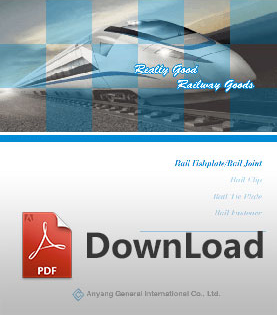Rail sleeper

Railway sleepers, also calledrailroad ties, railway ties or crossties, are an important railway component. Generally the rail sleeper is always laying between the two rail tracks to keep the correct space of gauge.What are railway sleepers made of? Having been developed for more than one hundred years, the railway ties need to meet the different requirements of the various railway tracks. In the past time, railroad ties were usually made of wood and had continued for about 50 years. Then with the development of steel tracks, steel sleepers appeared. And later, the first concrete sleeper experiment was made in Germany in 1906 between the line Nuremberg and Bamberg. In the recent time, concrete sleepers are widely used, especially in Europe and Asia. And in UK, steel ties are common. Besides, plastic composite ties are also employed in the rail track transportation.
Types of sleeper
Wooden sleeper
Historically wooden ties were made of a variety of softwood and some popular hardwoods such as oak, jarrah, karri etc. And they are only suitable for low speed lines with the limit speed of 160 km/h. As to acceptable species of wood for sleepers, the types are European oak, beech, pine etc. But nowadays, wooden sleepers are mostly replaced by concrete sleepers in some countries.

Advantage
- Easy to manufacture and handle Well electrical insulation
- Easily adapted to non-standard situations
Disadvantages:
- Non reusable
- Expensive of the limit wood resource
Steel sleeper
In recent times, steel sleepers mostly handle the heavy loads and can be designed to suit different rail track specifications. Because of the same weight as timber, steel sleeper can replace wood sleepers and be used on a ballasted bridge, providing a more durable and stronger solution without increasing bridge load.

Advantages:
- Easy to install and manufacture
- Handle more weight
Disadvantages:
- Sensitive to the chemical attacks
- Hard to maintenance
- Low transverse resistance
We supply steel sleepers of both UIC865 Series Steel Sleepers and BS-500 Series Steel Sleepers, with specifications as below.
| UIC865 Series Steel Sleepers | |||
| SIZE | STANDARD | MATERIAL | LENGTH |
| UIC54 | UIC865 | TO CUSTOMER'S REQUIREMENTS | TO CUSTOMER'S REQUIREMENTS |
| UIC60 | |||
| BS-500 Series Steel Sleepers | |||
| SIZE | STANDARD | MATERIAL | LENGTH |
| BS75A | BS 500-2000 |
SAE1522 ST52.3 20MnK SS490 Q255A |
1830mm
1900mm
2000mm
|
| BS75R | |||
| BS80A | |||
| BS90A | |||
| BS100A | |||
| BS113A | |||
Concrete sleeper
Compared with wooden sleepers, which are increasingly difficult and expensive to source in sufficient quantities and quality, concrete ties are cheaper and easier to obtain. In general, it can also be divided into pre-stressed mono block concrete sleeper and reinforced twin block concrete sleeper. Due to the greater weight which helps sleepers remain in the correct position longer, concrete ties require less maintenance than timber and own a longer service life. In some countries, concrete sleepers occupy a very important position. For example, on the highest categories of line in the UK, pre-stressed concrete ties are the only one permitted by Network Rail standards.

Advantages:
- Cheaper
- Easier to obtain
- Less maintenance
- Longer service life
Disadvantages:
- Hard to handle due to large weight
- Difficult to maintain longitudinal level due to higher
- Inertia moment and lower elasticity
You may also like:
- Comparison Of Railway Sleepers
- How much do you know about railway sleepers?
- A Guide of Concrete sleeper
- What Is A Timber Sleeper?
- Where to Buy Railway Sleepers?
- Railway sleeper materials overview: wood, steel, concrete, plastic
- How to build a raised bed with railway sleepers?
- How to fasten railroad screw spikes to railway sleepers
- Rail Fasteners
- rail fastening system
- rail clip
- railroad spike
- Track bolt
- rail shoulders
- rail anchor
- rail clamp
- tie plate
- Rail Pad
- rail insulator
- rail plastic dowel
- other rail fasteners
- Railway Switch
- SKL series rail fastening system
- Chinese standard rail fastening system
- screw spikes
- Crane rail fastening system
- K type rail clip for Africa
- Hey-Back Rail Fastening
- rail fasteners for Mexican market
- Ss25 screw spike
- Ss35 rail sleeper screw spike
- Ss8 screw spike
- coach screw
- Crane Rail Clip
- Rail Joints (Fishplate)
- Steel Rail
- Railway Sleeper
 rail clip
rail clip
 rail joints
rail joints

 Español
Español English
English
